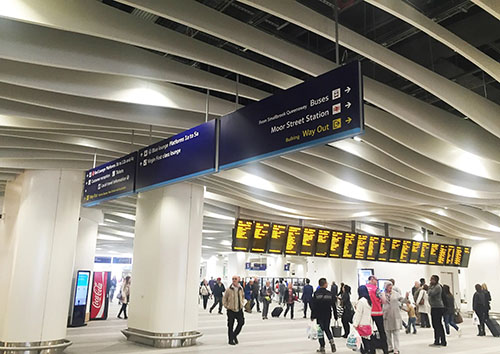Our Blog

Wayfinding signage manufacturers go out of their way to make their products stand out. But in the grand scheme of things, a wayfinding sign should be judged on the basis of the function it was designed to serve. With that in mind, you could say there are four major types of outdoor and interior wayfinding signage:
1) Direction Signs
These navigational aids are descendants of the original way-finder: that knobbly wooden signpost from days of yore. These days, most directional signage comes in the shape of a plaque mounted on a gantry before a junction. You'll often see this type of signage in hospitals, supermarkets, and warehouses too, but in the form of colour-coded stripes across the floor. And you might also come across interactive wayfinding kiosks on busy pedestrianised high streets or at transport hubs. They all serve the same purpose: to help you find your bearings and work out your route. But the key to this type of wayfinding signage is continuity. One wrong move or one poorly mounted sign, and you need to retrace your steps.
2) Identification Signs
These signs are used to identify an establishment and let travellers know that they have reached their destination. Outdoor identification signage might include historical markers like the iconic blue plaque, donor displays in parks, or terminal numbers displayed outside airport buildings. When it comes to interior wayfinding signage, this helps guide people within the building and let them know if they’ve reached the wrong room, so that they don't barge in. The list of examples includes Perspex office door signs (Boardroom, Managing Director), numbers in the middle of a baggage carousel at the airport, hospital departmental markers suspended from the ceiling (Accounting, Helpdesk, Radiology), but they can come in virtually any shape or size.
3) Information Signs
Informational signage helps the viewer navigate around a building or indoor space. But unlike directional or identification signage, it tends to include a great deal of additional information, usually emphasised with symbols. This may include the location of facilities like toilets, lifts, fire extinguishers, panic buttons, smoking areas, and fire exits, business information like opening hours and contact numbers, or amenities like Wi-Fi and electric car charging.
4) Warning Signs
These are proactive signs concerned with safety and liability. They set out and reinforce rules to do with privacy, safety standards, regulatory requirements, etc, and come with large and bold lettering, usually accompanied by symbols. You might see warning signs before sensitive storage rooms, where the use of PPE or other equipment is necessary and certain substances are forbidden. You might also see them in areas that are off limits to the general public, such as staff rooms. Given the nature of these signs, it's often necessary to comply with discrimination rules set out in the Equality Act 2020, which often involve using braille, tactile lettering, and audio signalling alongside symbols and letters, for the benefit of disabled passers-by.
Bespoke Signage From Image Technique
Whatever the setting, purpose, or specification, Image Technique can produce wayfinding signage to help your establishment communicate key messages to staff and visitors. With our all-inclusive signage and wayfinding service, you can make sure that users find their way through your facility safely, promptly, and independently. Get in touch today to find out more.



